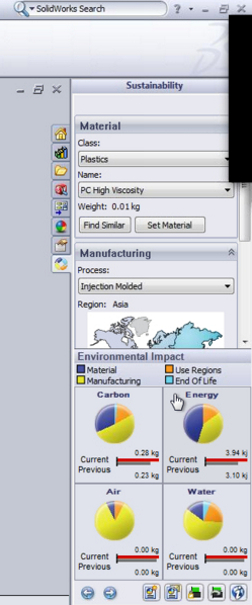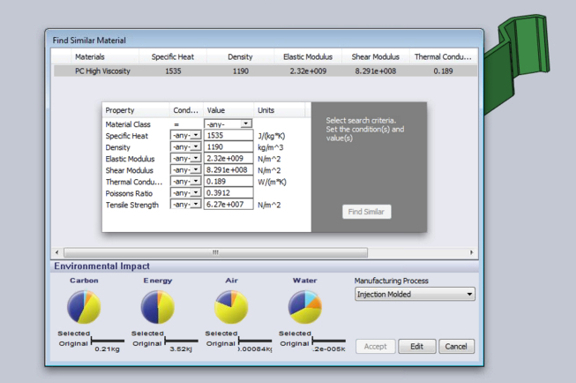July 1, 2009

In tough economic climates, most manufacturing considerations become questions about the bottom line: Sure, thickening the outer walls by 0.05 centimeter or switching to fire-resistant polyurethane will make the product much more durable. But how much will it cost? Can we afford that?
But there’s another kind of cost, measured not in dollars and cents but in carbon emission, fossil fuel consumption, and air and water pollution. We generally don’t think about that cost because it seldom appears in our balance sheets. So our natural resources—our rivers, forests, atmosphere, and soil—pick up the tab.
The new SolidWorks SustainabilityXpress module (beta version now available for download from SolidWorks Labs) might force us to confront this often overlooked cost. Accessible from within SolidWorks’ modeling environment, the new tool shows you the cost of design change in CO2, among others.
Those who attended SolidWorks World in February (Orlando, Florida) would remember SolidWorks CEO Jeff Ray introducing something codenamed SolidWorks Sage on stage. SustainabilityXpress is the official name of this feature, delivered in partnership with PE-International.
PE-International is known for GaBi, a software suite for lifecycle assessment. Part database and part software, Gabi lets users measure, document, and report carbon footprint, greenhouse gas, hazardous materials, and other green concerns in a manner consistent with the ISO 14040/44 standards.
The partnership with PE-International gives SolidWorks users access to the database on material properties, which plays a crucial role in how SustainabilityXpress provides instant feedback on your design decisions. Though a series of tabs and drop-down windows, SustainabilityXpress lets you pick your material, production site, manufacturing method, and where it will be used. The environmental impact of your choices are calculated and displayed in four categories: carbon, energy, air, and water.
This might allow you to see, for example, producing your bracket with injection molding in a facility in Detroit, Michigan, consumes a lot less fuel than producing it in a tooling factory in Tianjin, China (material transportation adds fuel). On the other hand, switching your material to polycarbonate with high viscosity might increase carbon output. In essence, you’re playing what-if scenarios with the major elements of your supply chain to gain insight into how your decisions will affect the environment.
Your findings can be exported as a Word document or a PDF file, so you can attach it to your proposal to your boss to explain why, even though it might cost the firm a bit more to make the new brand of tennis shoes in nylon-based material, it’s a more responsible choice for the environment.
SustainabilityXpress is expected to be included with the new SolidWorks 2010, so it won’t cost you extra to calculate the environmental cost of your design. A more comprehensive solution called SolidWorks Sustainability will be sold separately.

Subscribe to our FREE magazine, FREE email newsletters or both!
About the Author
Kenneth Wong is Digital Engineering’s resident blogger and senior editor. Email him at [email protected] or share your thoughts on this article at digitaleng.news/facebook.
Follow DE





